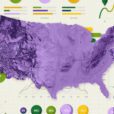Over the last 14 months, advocates, scientists, and policymakers have been calling for a green recovery to foster solutions that will benefit people and the planet for decades to come. The cornerstone of a green recovery must be investing in ways that help mitigate the climate crisis, while creating millions of good-paying jobs and addressing the nation’s infrastructure crisis through public investments.
Funding to jumpstart the country’s green recovery has already made its way to state and local governments. Passed in March 2021, the American Rescue Plan (ARP) provides $350 billion for state, local, territorial, and Tribal governments to address budget shortfalls and support recovery efforts, including some for infrastructure spending. President Biden put forward the American Jobs Plan, “a once-in-a-generation investment in America,” that would invest an additional $2 trillion in climate-friendly infrastructure shortly after signing the ARP.
Efficiently spending federal money in a way that centers people and the climate means state and local governments will need to prepare for and plan these investments now. This will first require taking stock of existing infrastructure needs and economic and racial inequities, and then carefully plan, scope, and analyze the benefits of potential investment options. Climate XChange’s recent research looks at what economic, social, and environmental benefits a green recovery could bring to Massachusetts — a state grappling with the dual challenges of addressing lasting effects of COVID-19 and meeting it’s new, ambitious climate goals.
An Infrastructure Crisis in Massachusetts
Overall, Massachusetts’ existing infrastructure is aging, inefficient, and fossil fuel-intensive, earning a C- grade from the American Society of Civil Engineers. Public transportation services earned the lowest grade of all infrastructure systems, with 23% of the state’s trains and transit vehicles currently operating past useful life. Those who take public transit spend an extra 53% of their time commuting, and non-White households are twice as likely to commute via public transportation.
Paired with frequent operating delays, the poor quality of public transportation infrastructure has made commuting difficult and kept many people in private cars. However, those familiar with Boston’s notorious congestion problem know that driving is also an undesirable alternative to public transit. Driving on congested, poorly maintained roads costs drivers in the state an extra $620 every year in wasted time and fuel, and leads to worsened air quality and public health outcomes.
The state’s housing, energy, and water needs are also pressing. Nearly half a million renters in Massachusetts are cost burdened, meaning they spend more than 30% of their income on rent. Low-income families spend 6-8% of their income on home energy costs alone, and 11% of the population does not have an internet subscription. Many residents lack access to clean and affordable drinking water, requiring an additional investment of $12 billion to adequately meet this need.
At the same time, communities have long been victims of the catastrophic impact that air pollution has on public health. A shocking report from Harvard University found that fossil fuel pollution causes close to one in five deaths globally, including more than 7,600 deaths in Massachusetts every year. Air pollution also causes higher risk of cardiovascular and respiratory diseases and cancer.
COVID-19’s Lasting Impacts
Long-term exposure to air pollution has also devastatingly impacted communities during the COVID-19 pandemic. Individuals experiencing the worst air pollution are the most at risk of fatality from COVID-19. Researchers from the Harvard T.H. Chan School of Public Health measured this correlation, and found that a one microgram per cubic meter increase in long-term exposure to PM2.5 leads to an 11% increase in mortality from COVID-19. Communities with more people of color, such as Chelsea, Brockton, and Lawrence, bear the highest rates of air pollution exposure, and experienced higher COVID-19 infection and mortality rates across nearly 40 of the largest cities in Massachusetts.
At the peak of the COVID-19 pandemic, unemployment reached a historic high of 16.4% in April 2020, and was the highest in the country in July 2020. As of October 2020, around 160,000 households owed back rent, of which 60,000 households feared imminent eviction. Another 235,000 renters and homeowners anticipated having trouble paying their rent or mortgage. Unemployment remains high more than a year into the pandemic and economic crisis, making it difficult for individuals and families to pay for food, housing, medical care, and other necessities.
Green Investments in Massachusetts
These hardships have increased the urgency to invest in a way that delivers new family livelihoods, positive health outcomes, and an improved quality of life for residents of the Commonwealth. In addition, the landmark climate bill, An Act Creating a Next Generation Roadmap for Massachusetts Climate Policy, passed into law in 2021, legally requires the state to cut greenhouse gas emissions in half relative to 1990 levels by 2030, and to achieve net zero emissions by 2050.
Climate and infrastructure investments present an opportunity to jointly address the compounding economic and public health crises, and to set the state on a path to achieve its required emissions reductions. And we’ve learned key lessons for using climate investments as tools for recovery from the last serious economic crisis.
The 2009 American Recovery and Reinvestment Act (ARRA)
Also known as the Recovery Act, ARRA is the largest single investment in clean energy in U.S. history to date at $240 billion in federal, state, and private spending. Most of this funded projects to modernize the country’s energy, transportation, building, and water infrastructure, with smaller investments in green job training and research and development.
“Shovel-ready” climate investments enabled by ARRA got people back to work quickly and efficiently, while returning an economic benefit of $2.20 per dollar invested. These investments supported 900,000 full-time jobs between 2009 and 2015 from federal spending alone, and were some of the most cost-effective job creators across all ARRA measures. On top of that, they laid the groundwork for unprecedented growth in clean energy and energy efficiency in the decade that followed.
Looking at these high-level metrics, Recovery Act investments appear to have been successful. However, taking a closer look highlights some of the pitfalls of the stimulus package. The biggest criticism of ARRA was that it was too small to fully address the Great Recession, resulting in an economic recovery that was slower than necessary.
Beyond economic metrics, the Recovery Act underperformed on environmental and social measures. Investments failed to make a significant impact on U.S. greenhouse gas emissions — its size and short spending time frame favored fossil fuel-dependent infrastructure and largely stifled innovative, transformative climate projects as well as thorough community engagement. Similarly, the ARRA did not take a holistic approach to recovery, and prioritized rapid job growth over quality of life benefits or advancing environmental justice.
Investing in the Future
We have an unprecedented opportunity to build on our successes, learn from our mistakes, and foster economic prosperity, climate action, and community well-being. States will play a crucial role in deciding how federal stimulus dollars are dispersed and spent — meaning their decisions will likely have lasting impacts on economic recovery and the climate crisis.
Massachusetts received close to $5.3 billion from ARP in May and has until 2024 to spend it. Yet policymakers still have not decided who is in charge of spending federal money, let alone how to spend it.
Successful public investment strategies require decision-makers to deeply understand the solutions on the table, the scale of funding needed, and the economic, social, and environmental benefits. The central thesis of this benefit evaluation framework is simple: governments must expand beyond antiquated metrics such as gross domestic product when evaluating the cost-benefits of budgets and policy decisions. Representing the public interest requires measuring many aspects of community well-being, including job opportunities, income levels, cost and time savings, public health improvements, and ecosystem and climate benefits.
Our most recent report, Investing in a Better Massachusetts: An Analysis of Job Creation and Community Benefits, puts these principles to the test. We modeled what an illustrative portfolio of 18 public investment programs would mean in terms of job creation and community well-being in Massachusetts. These investments, which we collectively refer to as the Green Investment Portfolio, span transportation, housing, clean energy, grid modernization, and natural resource conservation.
The Green Investment Portfolio supports superior job creation, supporting 14 jobs for every $1 million invested. To put this into perspective, these programs support nearly twice as many jobs per dollar than the state’s ten largest industries and 65% more jobs per dollar than the state’s overall economy.
These jobs cut across many different industries and occupations, with particularly strong job creation in construction, architecture and engineering services, and health and family services — the types of jobs that provide higher rates of family-supporting wages, access to health insurance, unionization, and opportunities to build long-term wealth and make career advancements compared to the state average.
Beyond job creation, these infrastructure programs also offer widespread, tangible benefits for individuals and communities in the form of lower energy costs, faster and more accessible transportation, cleaner air, and better quality of life. Every dollar invested in the Green Investment Portfolio returns over two dollars in cost savings and public health benefits.
Massachusetts will soon need to implement recovery investments at a scale far beyond previous stimulus measures and build a comprehensive vision for what a climate-aligned recovery could look like. When the benefits of doing so are captured and expressed in dollar terms, our research reveals that public investment in a green transition is immensely beneficial to the Commonwealth’s job market, economic vitality, and community well-being, even beyond the pressing needs to address the climate crisis.









